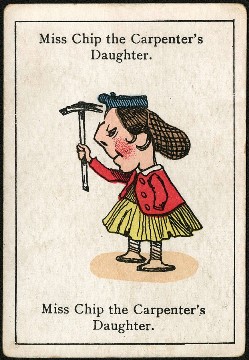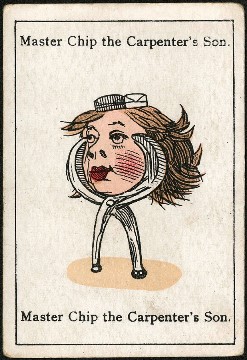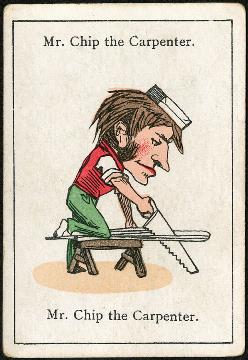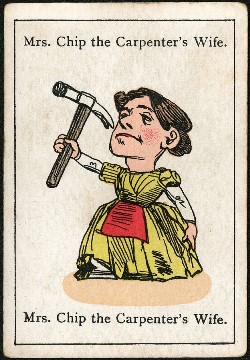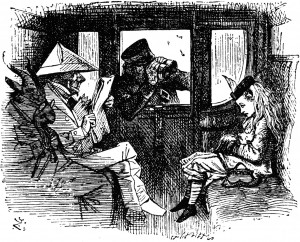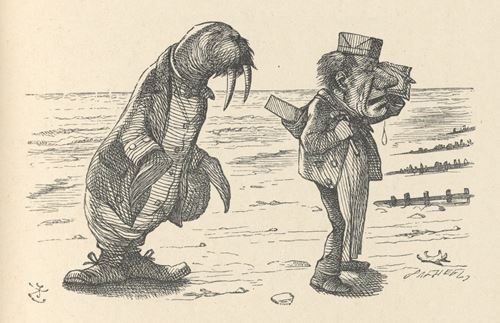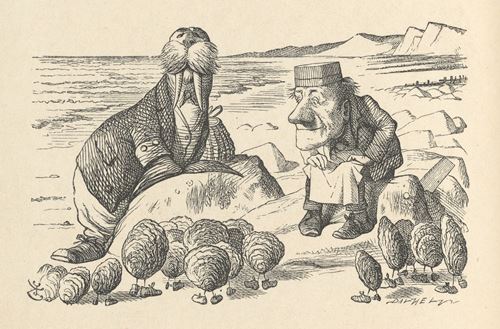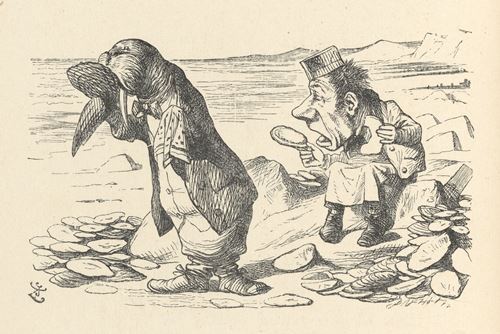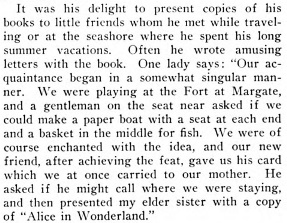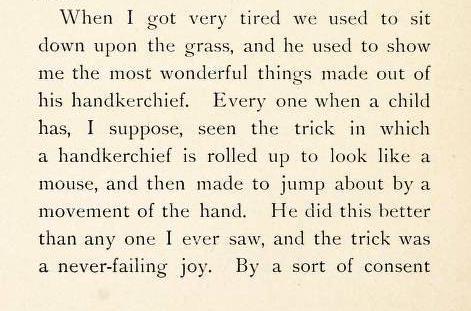| The Public Paperfolding History Project
Last updated 24/12/2024 x |
|||||||
| Charles Dodgson (aka Lewis Carroll) / John Tenniel | |||||||
| This
page attempts to record what is known about the
paperfolding of Charles Dodgson (aka Lewis Carrol) and in
the illustrations of John Tenniel. Please contact me if
you know any of this information is incorrect or if you
have any other information that should be added. Thank
you. ********** 1851 In 1851 John Jaques and Son Ltd are said to have commissioned John Tenniel to design a set of cards for a new game to be called Happy Families, which is said to have been displayed at the Great Exhibition at the Crystal Palace in London in that same year (although John Jaques and Son Ltd are not listed as contributors in the official catalogue). The set included the four cards shown below, in two of which the characters are wearing Workman's Hats. Source: Jaques’ Happy Families — The World of Playing Cards citing 'Happy Families... an old game with new faces' published in the Newsletter of the English Playing Card Society, edited by Major Donald Welsh, Vol.9 No.38, Nov.1992, pp.78-81. However, note that the attribution of these designs to John Tenniel has been questioned on stylistic grounds.
********** 1871 A John Tenniel illustration, this time for Lewis Carroll's 'Through the Looking-Glass, and What Alice Found There', first published in 1871, shows Alice in a railway carriage sitting opposite a man wearing a white paper suit and a Newspaper Hat. According to Martin Gardner (in 'The Annotated Alice, 1998, p.218) the fact that the man is dressed in white paper is a political joke. He believes that Tenniel’s illustration shows a cartoon of Benjamin Disraeli and that Tenniel may have had in mind the ‘white papers’ (official documents) with which such statesmen are surrounded. Before he illustrated the Alice books, Tenniel had once portrayed Disraeli in a Government White Paper suit. However, Michael Hancher, writing in 'The Tenniel Illustrations to the ‘Alice’ Books, 1985' disputes this identification as the man in white paper does not have the obvious chin or goatee, which are normally present in Tenniel’s caricatures of Disraeli. Source: http://www.alice-in-wonderland.net/resources/analysis/picture-origins/
********** 1872 These illustrations by John Tenniel were drawn for the Lewis Carroll poem 'The Walrus and the Carpenter', first published in 1872, show the Carpenter wearing a Workman's Hat.
********** 1885 While Lewis Carroll may have valued paper folding as a way of entertaining children (see below) he was not a fan of paperfolding as a way of teaching mathematics. On page 11 of his book 'A History of Folding in Mathematics', Birkhauser, 2018, Michael Friedmann refers to Charles Dodgson's book 'Euclid and his Modern Rivals', published in 1885, in which, inter alia, he compares Euclidean proofs with proofs based on paperfolding and remarks ' ... (a)ll that about folding and re-folding the paper is more like a child's book of puzzles than a scientific treatise. I should be very sorry to be the school-boy who is expected to learn this precious demonstration!' ********** 1889 onwards In 1972 the British Origami Society issued Pamphlet No 1 'Some Notes on the History of Origami' which was written by John Smith. In August 1973 a revised version was issued which included some additional notes on Lewis Carroll's paper folding. In this revised booklet John Smith gave 7 excerpts from Lewis Carroll's diaries which mention paper folding. These can also be found on his website at http://www.britishorigami.info/academic/johnsmith/history_notes.php which also gives sources and page numbers for them (which I have not checked). In date order these are: June 7th 1889 - 'With ... Princess Alice and her brother, Duke of Albany ... and folded a fishing boat for them.' October 2nd 1890 - 'Called on Mrs Fox with whose children I began an acquaintance at the concert the other night: Annie (aged 8) and Stanley. Today I borrowed the children for an hour and took them to my lodgings and folded fishing boats for them, etc.' October 8th 1890 - '... and the little boy Francis Epipharius (Piffy), a very bright little creature, who taught me how to fold paper pistols ...' October 1891 - 'Princess Alice and the little Duke of Albany, however, paid him a visit and were initiated in the art of making paper pistols.' November 16th 1891 - 'The Duchess of Albany is at the Deanery with her children and sent the children to my rooms soon after 10 ... and I taught them to fold paper pistols ...' January 26th 1897 - 'In the afternoon I went to Godalming and had tea with the vicar, and folded a fishing boat and paper pistol for his little Mary.' August 28th 1897 - 'Fetched Edith Wardell to tea, and little Nora Charrington, aged 7, for whom I folded a fishing boat etc.' *** There is also a passage in the Easy Read Comfort Edition of 'The Life and Letters of Lewis Carroll' published by ReadHowYouWant in 2008 and dated to June 1889 which reads: 'Once at luncheon I had the Duchess (of Albany) as neighbour and once at breakfast, and had several other chats with her, and found her very pleasant indeed. Princess Alice is a sweet little girl. Her little brother (the Duke of Albany) was entirely fascinating, a perfect little prince, and the picture of good-humour. On Sunday afternoon I had a pleasant half-hour with the children, telling them "Bruno's Picnic" and folding a fishing-boat for them.' *** On his website 'Bits of Smith', John Smith also gives another reference from 'The Magic of Lewis Carroll', edited by John Fisher, Nelson, 1973, in which he quotes a passage which reads. "We were playing on the fort at Margate, and a gentleman on a seat near asked us if we could make a paper boat, with a seat at each end and a basket in the middle for fish." This sounds like a description of either the Chinese Junk or the Gondola. No date for this incident is given, however, this description suggests that the folded paper fishing boats referred to on several other occasions in Lewis Carroll's diaries might have been Chinese Junks or Gondolas rather than, as I had always previously assumed, the much simpler Paper Boat design made from the Newspaper Hat. A description of this same incident is quoted in the September 1908 issue of the American children's magazine St Nicholas, in an article about 'How "Alice in Wonderland" Came to be Written'. It reads:
The passage quoted as 'One lady says' can be found attributed to Miss F Bremer, 'Another child-friend', in 'The Life and Letters of Lewis Carroll' by Stuart Dodgson Collingwood, which was published by T Fisher Unwin in London in 1899. *** The other design mentioned in these excerpts, the paper pistol, is harder to identify. It is probably what we now call the paper banger, but it is also possible that it could be the two-piece pistol made from rolled sheets of paper, or something else entirely. There is simply no evidence to tell us. ********** 1900 In her book 'The Story of Lewis Carroll', which was published by E P Dutton in New York in 1900, Isa Bowman mentions Lewis Carroll entertaining her with a handkerchief mouse.
********** |
|||||||
